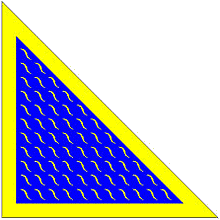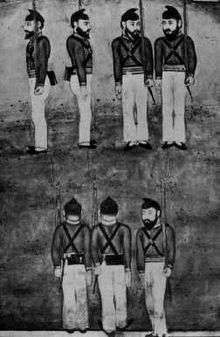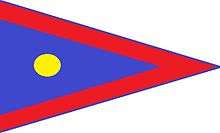Fauj-i-Khas
| Fauj-i-Khas | |
|---|---|
 Fauj-i-Khas infantry regimental standard | |
| Active | 1805–1849 |
| Country |
|
| Size | 5,500 (Total) |
| Garrison/HQ | Lahore, Attock , Kangra, Multan , Peshawar |
| Nickname(s) |
Campu-i-Mualla(The Maharaja's own legion) Campu Fransez (French Legion) |
| Motto(s) | Deg Tegh Fateh |
| Engagements | Afghan-Sikh Wars, Sino-Sikh War, Anglo-Sikh Wars |
| Commanders | |
| Notable commanders |
Hari Singh Nalwa Maharaja Ranjit Singh of Punjab Gurmukh Singh Lamba Lehna Singh Majithia Dal Singh Nahama Jean-Francois Allard Jean-Baptiste Ventura |
The Fauj-i-Khas was a brigade of the Fauj-i-Ain section of the Sikh Khalsa Army of Punjab. It consisted of very experienced elites and had separate flag and emblem. Its commands were purely in French. It was strictly disciplined on French pattern. All the equipment and weapons were of the best type. It grew to be the best organised section of the regular army (Fauj-i-Ain)

Background
Before the reign of Maharaja Ranjit Singh the armies in Punjab were consisting purely of cavalry. As Ranjit Singh became the Sardar of Sukerchakia Misl he tried to unify with his conquests most of the Punjab. With clever diplomacy and many battles he gradually unified most of Punjab under him. However the Afghans, The British and the Gurkhas were still a very big threat,while his empire was still in its infancy. Therefore, in 1805,he started recruiting regular forces and employing East India Company deserters as officers or soldiers. This didn't went very well as most of these deserters were constantly in touch with the British. The British where alarmed with the rapid conquests of Ranjit Singh and sent many diplomatic missions to help the Phulkian sardars from a possible conquest of their lands and check the growing power of the Sikh Sovereign.
A Muslim regiment under Charles Metcalfe, 1st Baron Metcalfe was sent to Amritsar for talks with the Maharaja.The soldiers went into the temple without taking their shoes off,and some Nihang guards unsheathed their sabres and challenged them. The Muslim soldiers formed line and shot many Musket volleys. It resulted in the death of many Nihangs, while others were wounded. This impressed Ranjit Singh and left a deep impact on him. Realising the power of the British Army,he accepted The Treaty of Amritsar (1809),and started modernizing his army on European principles

Formation
It was the Maharaja Ranjit Singh who started to hire European officers to train and command parts of his army. The Fauj-i-Khas was a model brigade trained and equipped after European model under the command of General Jean-Baptiste Ventura. It consisted of 11000 horsemen(Ghor Charras), divided into fifteen Dera led by eminent sardars, among them Sham Singh Atariwala, Gurmukh Singh Lamba, Hari Singh Nalwa, and two by non Sikhs, the Mulraj Derah of Dewan Mulraj and Dorgra Derah of Dhian Dogra.Izazi-i-sardari was the highest honour,most distinguished Sikh generals,sardar Gurmukh Singh Lamba, Hari Singh Nalwa, and Dal Singh Nahama were the recipient.


Emblems
The Fauj-i-Khas had its own French flag,with the Persian inscription of the motto of the Sikh Khalsa Army:"Deg Tegh Fateh.It had also many banners,all of them blue in colour with circles,horses,flowers and corn plants
Size
The Fauj-i-Khas had 4 battalions of infantry, 2 regiments of cavalry and a troop of artillery. The cavalry was built on a British model and the infantry on French pattern. This was the first unit in the army to be equipped European-style. Impressed by its performance, the Maharaja ordered a total reorganisation of his whole regular force on the model of Fauj-i-Khas in 1835. This alarmed the British, who had come to see the emerging military power of Punjab as a threat, to such a degree that they in 1837 issued orders to be vigilant and try to arrest any French officer travelling in disguise to join Ranjit Singh’s army.

Before Ranjit Singh, the Punjab army was mainly a pure cavalry army. Under the supervision of the European officers, and encouragement by the Maharaja, the infantry and artillery gained importance, and by the time of the death of Ranjit Singh, the infantry service had become the preferred service in the army.
Commanders
Over the years many Europeans served in the army of the Punjab. Among them:
- General Jean-François Allard (cavalry) - French
- General Paolo Di Avitabile (infantry) - Italian (Naples)
- General Jean-Baptiste Ventura (infantry) - Italian (Modena)
- General Claude August Court (artillery) - French
- Colonel Alexander Gardner (artillery) - American (Wisconsin)
- Colonel John Holmes - Anglo-Indian
Sources
- Major Pearse, Hugh; Ranjit Singh and his white officers. In Gardner, Alexander (1999) [1898]. The Fall of Sikh Empire. Delhi, India: National Book Shop. ISBN 81-7116-231-2.
- Fauj-i-khas Maharaja Ranjit Singh and His French Officers, by Jean Marie Lafont. Published by Guru Nanak Dev University, 2002. ISBN 81-7770-048-0.
- The Sikh Army 1799-1849 By Ian Heath, Michael Perry
- Maharaja Ranjit Singh By Jean Marie Lafont (Page 59,146,148)